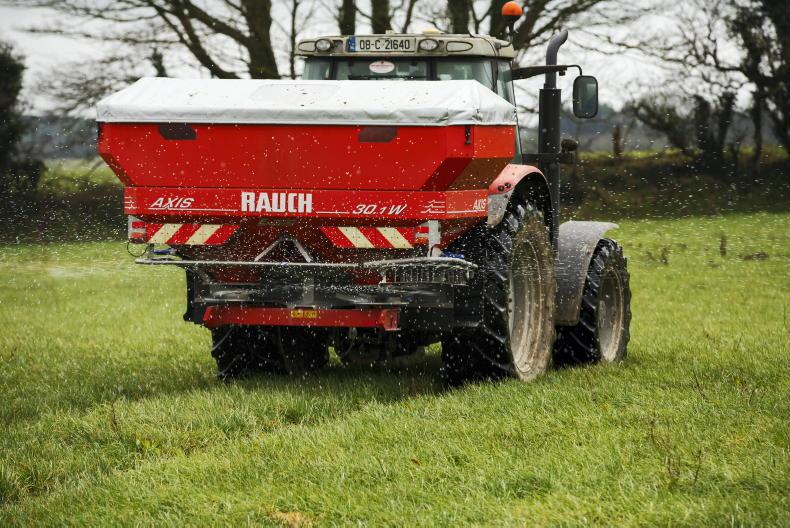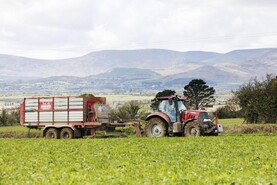Over the course of the spreading season, the trusty fertiliser spreader should often be checked over and calibrated to ensure the desired application rate is being met.
With fertiliser being such an expensive commodity, it is important that it is spread accurately and evenly. The spreader will only do this if it is set up and working correctly.
Machine inspection
First off, inspect the frame, the hopper and spreading mechanism for signs of wear or fatigue. Cracks or corrosion may affect its overall load-carrying ability.
Similarly, the hopper should be crack-free and its shutters in good working condition. For example, closing fully when closed and opened evenly to the desired setting.
Worn linkages or other regulator components can affect a spreader’s output and may result in an uneven application to a particular side.
Good vanes are critical in achieving an accurate spread pattern. Vanes that have a rough or wrinkled surface and leading edge that isn’t straight will need to be replaced.
A small bit of wear here may have a large effect on the machine’s spread pattern, especially at wider bout widths.
Bearings should be checked for wear. On a disc machine, do this by shaking each of the discs vertically.
Ideally there should be no wobble or the chances are there is a bearing and/or shaft(s) need replacing.
The agitator bearing should be also checked, along with any other moving parts. All grease points should be greased before mounting on the tractor.
If fitted with a headland management system, make sure it is engaging and disengaging fully.
Depending on the machine, this is either done via deflector kit or by changing the direction of the discs so that discs rotate in the opposite direction.
Tractor mounting
The drop arms should be measured with a tape and be of equal length before mounting.
Once the spreader is mounted, the stabilisers should be snug, with the spreader centrally mounted; any play here will affect spread pattern.
Raise the spreader to the correct working height and adjust the toplink so that the spreader is sitting at the angle as advised by the manufacturer or spread chart.
The general rule of thumb is 75cm from the top of the crop to the spreading mechanism (discs or the wagtail). If possible, check and ensure rear tyre pressures are equal.
Disc spreader calibration
A disc machine has two main areas of adjustment - fertiliser flow rate from the hopper and disc and vane settings. The steps involved in setting the flow rate on both wagtail and disc machines are similar.
Depending on the spreader, vane type/position, fertiliser drop point, disc size and toplink angle may need to be adjusted in accordance with the spreading chart for the selected product at the set working width (m), application rate (kg/ha), forward speed (km/h) and type of fertiliser being applied.
These adjustments vary from brand to brand, so you will need to refer to the associated manufacturer’s settings and spread charts.
Most manufacturers have mobile phone apps that show spread charts and have calculators that allow you to input the spreading variables and desired criteria before providing the relevant machine settings to achieve this.
Most manufacturers have a sizeable selection of fertiliser types and brands already tested in their test halls.
The spread chart will also indicate the accurate kg/min for each particular fertiliser to suit each particular machine.
To calibrate, shut off one side and remove the disc on the other side before fitting on the calibration container.
The spreader should be run for one minute while the container gathers the fertiliser. The container’s weight after one minute should match the kg/min rate as displayed by the app or spread chart.
Wagtail calibration
A wagtail spreader has only one area of adjustment – the flow rate. Flow rate on a wagtail is adjusted by moving the regulator.
The one regulator setting will not work for all fertilisers, as flow rates vary depending on the fertiliser’s characteristics (shape, size and even the brand). No two samples are the same.
To calibrate a wagtail, remove the spout and fit on a calibration container. The app or spread chart will provide a rate in kg/min which should match that coming from the spreader.
Run the spreader at the setting recommend by the app or spread chart and then weigh the fertiliser that came out over the course of the minute.
If the two figures don’t match up, some fine tuning may be required. Once the flow rate has been set using the regulator, a wagtail requires no further setting up.
In the field
Once the machine has been correctly set up, the operator needs to drive accurately in the field.
They need to ensure both the PTO and forward speed is correct and that the correct bout width is being maintained.
Once the PTO speed has been set to 540rpm, forward speed can be altered by changing gears.
When using a wagtail/pendulum-type spreader with a working width in the region of 10m to 12m, it’s reasonably easy to maintain an accurate bout width by eye.
Once working with wider bout widths or spreading in a recently cut field, it becomes much more difficult to maintain accuracy.
Users of such machine should consider an entry-level GPS system to help cut out overlapping and reduce fertiliser usage.

\ Donal O' Leary
Over the course of the spreading season, the trusty fertiliser spreader should often be checked over and calibrated to ensure the desired application rate is being met.
With fertiliser being such an expensive commodity, it is important that it is spread accurately and evenly. The spreader will only do this if it is set up and working correctly.
Machine inspection
First off, inspect the frame, the hopper and spreading mechanism for signs of wear or fatigue. Cracks or corrosion may affect its overall load-carrying ability.
Similarly, the hopper should be crack-free and its shutters in good working condition. For example, closing fully when closed and opened evenly to the desired setting.
Worn linkages or other regulator components can affect a spreader’s output and may result in an uneven application to a particular side.
Good vanes are critical in achieving an accurate spread pattern. Vanes that have a rough or wrinkled surface and leading edge that isn’t straight will need to be replaced.
A small bit of wear here may have a large effect on the machine’s spread pattern, especially at wider bout widths.
Bearings should be checked for wear. On a disc machine, do this by shaking each of the discs vertically.
Ideally there should be no wobble or the chances are there is a bearing and/or shaft(s) need replacing.
The agitator bearing should be also checked, along with any other moving parts. All grease points should be greased before mounting on the tractor.
If fitted with a headland management system, make sure it is engaging and disengaging fully.
Depending on the machine, this is either done via deflector kit or by changing the direction of the discs so that discs rotate in the opposite direction.
Tractor mounting
The drop arms should be measured with a tape and be of equal length before mounting.
Once the spreader is mounted, the stabilisers should be snug, with the spreader centrally mounted; any play here will affect spread pattern.
Raise the spreader to the correct working height and adjust the toplink so that the spreader is sitting at the angle as advised by the manufacturer or spread chart.
The general rule of thumb is 75cm from the top of the crop to the spreading mechanism (discs or the wagtail). If possible, check and ensure rear tyre pressures are equal.
Disc spreader calibration
A disc machine has two main areas of adjustment - fertiliser flow rate from the hopper and disc and vane settings. The steps involved in setting the flow rate on both wagtail and disc machines are similar.
Depending on the spreader, vane type/position, fertiliser drop point, disc size and toplink angle may need to be adjusted in accordance with the spreading chart for the selected product at the set working width (m), application rate (kg/ha), forward speed (km/h) and type of fertiliser being applied.
These adjustments vary from brand to brand, so you will need to refer to the associated manufacturer’s settings and spread charts.
Most manufacturers have mobile phone apps that show spread charts and have calculators that allow you to input the spreading variables and desired criteria before providing the relevant machine settings to achieve this.
Most manufacturers have a sizeable selection of fertiliser types and brands already tested in their test halls.
The spread chart will also indicate the accurate kg/min for each particular fertiliser to suit each particular machine.
To calibrate, shut off one side and remove the disc on the other side before fitting on the calibration container.
The spreader should be run for one minute while the container gathers the fertiliser. The container’s weight after one minute should match the kg/min rate as displayed by the app or spread chart.
Wagtail calibration
A wagtail spreader has only one area of adjustment – the flow rate. Flow rate on a wagtail is adjusted by moving the regulator.
The one regulator setting will not work for all fertilisers, as flow rates vary depending on the fertiliser’s characteristics (shape, size and even the brand). No two samples are the same.
To calibrate a wagtail, remove the spout and fit on a calibration container. The app or spread chart will provide a rate in kg/min which should match that coming from the spreader.
Run the spreader at the setting recommend by the app or spread chart and then weigh the fertiliser that came out over the course of the minute.
If the two figures don’t match up, some fine tuning may be required. Once the flow rate has been set using the regulator, a wagtail requires no further setting up.
In the field
Once the machine has been correctly set up, the operator needs to drive accurately in the field.
They need to ensure both the PTO and forward speed is correct and that the correct bout width is being maintained.
Once the PTO speed has been set to 540rpm, forward speed can be altered by changing gears.
When using a wagtail/pendulum-type spreader with a working width in the region of 10m to 12m, it’s reasonably easy to maintain an accurate bout width by eye.
Once working with wider bout widths or spreading in a recently cut field, it becomes much more difficult to maintain accuracy.
Users of such machine should consider an entry-level GPS system to help cut out overlapping and reduce fertiliser usage.

\ Donal O' Leary







 This is a subscriber-only article
This is a subscriber-only article









SHARING OPTIONS: